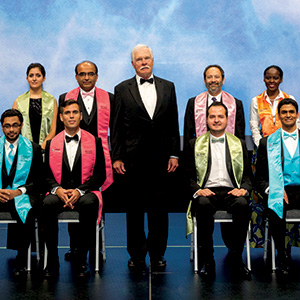

Sometimes technology really does work for the common good. Just a few short weeks ago, the annual Tech Awards drew hundreds of black ties and yours truly to the McEnery Convention Center.
As was announced, the Mouth of the South himself, Ted Turner, legendary founder of CNN and however many movie channels 30 years ago, received the James C. Morgan Global Humanitarian Award. Turner, of course, is not your usual billionaire. He actually gives back. He seems to care about poverty, world hunger, environmental health, sustainable energy and other issues that plague the globe. A self-proclaimed optimist, Turner started the UN Foundation, providing one billion smackeroos, and he still remains its current chairman. All of which resulted in him receiving global humanitarian accolades.
This year, the awards were given to 10 international teams of laureates involved with life-changing work around the world. Here’s how it usually begins: During the pre-event reception, the laureates stand at their respective tables and demonstrate their research projects and/or inventions while the black ties walk up with glasses of Chardonnay and simply engage. Then the ceremonies begin. Since the Convention Center recently expanded to include a new grand ballroom, the Tech Awards took place in the ballroom for the first time.
The scene was one of pure inspiration, to be honest. The laureates, brainy folk of all ages and nationalities, with all sorts of scientific expertise, exuded a commitment to curiosity, constant learning and finding new ways to help impoverished areas of the world. It was not the standard, lanyard-clad conventionfolk one normally sees crammed into one place in just any building. Plus, the optimism was infectious. I can’t speak for the black ties, since I showed up in beat-up Tandoori-colored khakis, but I came away totally inspired. I envisioned somehow seguing into global humanitarian work, someday. Seriously. It was a dignifying experience.
On that note, allow me to highlight some of the work the laureates are up to. Source International, in one case, provided technology and training for poverty-stricken areas of Honduras to to examine their water, air, and soil for chemical contaminants dumped into the environment by corrupt mining companies. For years, indigenous peoples living near the mines and drilling sites were suffering severely, women were having miscarriages and kids were developing welts due to chemicals dumped into their drinking water. But none of them had the tools to prove the amounts of contaminants present. So, Source International developed a suite of scientifically-validated testing technologies enabling the community to examine their water, air, and soil for a variety of chemical contaminants, and it trained them in how to use the resulting data to go after the corrupt mining company. As a result, the country changed its mining laws and the mining company was forced to shut down its operation. Bravo!
In another case, a company called Nanoly, employing a team of young scientists, developed a biomaterial that enables vaccines to travel without being refrigerated. As a result, recipients in places like rural Indian villages, who previously would have died due to a lack of safe and functioning vaccines, are now saved. One of the scientists, an Indian American, said he was motivated by stories from his parents about people in villages back home who could never get vaccines in time.
Every other laurete exemplified similarly inspiring stories. The use of massive wealth for common good was a breath of fresh air.
Simran Sethi, known for sustainability-issues journalism, emceed the entire ceremonies and even broke down in tears on stage. That’s how inspiring it was to be on the same platform as these heroes and in the same room as ultra-rich Silicon Valley folk who fund such groundbreaking research. A week later, I caught up with her over the phone from Trinidad. She was still blown away.
“Those people are the key in the lock that changes the world,” Sethi told me. “There is so much wealth and so much capacity in Silicon Valley, and I think every one of those people in the room exhibited the same qualities to get where they are, the same qualities that the laureates exhbited—that tenacity, that curiosity, that creativity. And to parlay that into something that can be so transformative is, to me, really amazing.”



